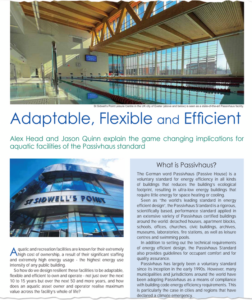
Australasian Leisure Management magazine has published a great article on Passive House aquatic facilities by Alex Head from Architecture HDT Christchurch and Sustainable Engineering’s Jason Quinn.
As Alex explains, “aquatic and recreation facilities are known for their extremely high cost of ownership, a result of their significant staffing and extremely high energy usage—the highest energy use intensity of any public building.”
Both Alex and Jason were involved, with many others, in a concept feasibility study for a large new aquatic facility in the North Island. The study concluded that on the basis of net present value, a facility certified to the Passive House standard offered nearly $7 million more value compared to a 5 Green Star rating. That represented 10% of the total project cost.
The Passive House option was estimated to cost an extra 5%. This “capital cost investment was more than compensated for by the whole of life savings which in net present value terms equated to savings over the 50-year life of the facility equating to 10% of the capital cost budget,” the authors note.
Ultimately, the building owner/operator did not choose the Passive House option. “I’m still quite sad we didn’t get to build a certified Passive House aquatic centre,” says Jason. “But given the significant returns on capital, lowered CO2 emissions, and many other benefits it is only a matter of time before an aquatic centre in New Zealand is designed and built this way.”
Here is a summary of the top ten “big levers”. Read the magazine article (pp 24-29) for more information on each. Note that in many cases, these were remarkably synergistic:
- Thermal zoning of spaces.
- Simple form factor. (external surface area to useful floor area of the thermal envelope)
- Super well insulated.
- Glazing / window optimisation.
- Eliminate cold bridges
- Airtight building enclosure
- Mechanical plant inside the thermal envelope
- Pool plant very close to pools and inside the thermal envelope
- Water slides within thermal envelope
- Air temperatures 2C above water temperatures
Comments 1
Nice article. Can I ask how you tested for ‘big lever’ no. 10? I’ve seen it before in other places, but rarely is there a reference.